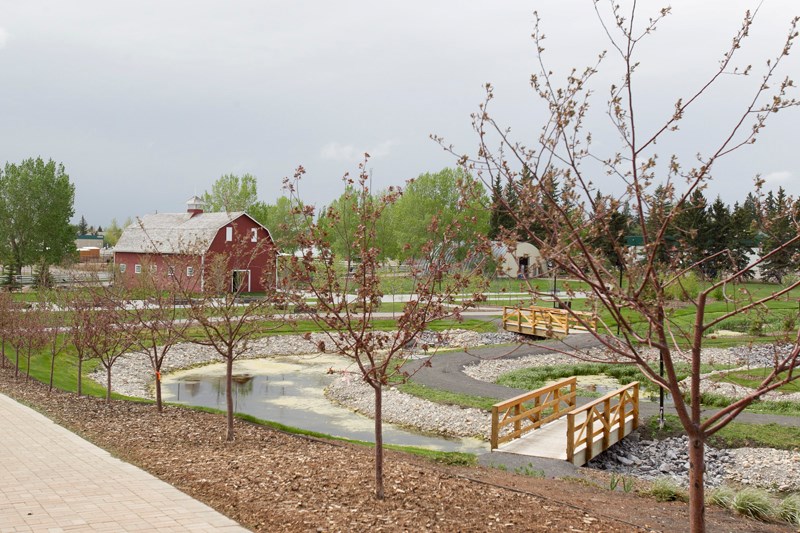For Jane Reksten, the 10 hectares of ponds, trees, walkways and plants on the northeast edge of Olds College's campus isn't just a re-creation of a wetland system.
It's a “living classroom.”
The school is putting the final touches on its new Botanic Gardens and Treatment Wetlands project, which Reksten, the project's manager, said will allow researchers and students to study how wetlands affect water quality and give gardeners the chance to explore an environment containing hundreds of different types of land-based and aquatic plants.
The wetland project is the third phase of the college's botanic gardens, with the first two phases located in front of the school's Land Sciences Centre.
Reksten, who is a graduate of the college's horticulture diploma program, said the new phase was announced at the time the first two phases were completed in 2002 and it has taken the last five years to prepare the wetlands for their grand opening, which will take place in September.
Here's how the system works.
Water runoff from campus is funnelled into a large pond on the project's north end and then travels to a larger holding pond to the east where some of the water is used to irrigate the hundreds of species of plants found throughout the gardens.
A powerful pump then transports water from the large holding pond to the west side of the wetlands into nine “polishing” ponds, which are used for water treatment research, or a number of “ornamental” ponds, Reksten said.
Overall, there are 19 ponds throughout the wetlands.
Four recirculation pumps are then used to “manipulate” water levels in the ponds for research purposes, she added.
Each polishing pond contains one unique species of plant so researchers can explore how a specific type of wetland vegetation affects water quality.
For example, Reksten said, researchers could explore how well certain wetland environments can clean some of the pollutants coming off of the school's campus parking lots, such as oil and de-icing chemicals, from water passing through a particular pond.
“What is the water quality when it comes in and what is it when it goes through all these ponds,” she said.
Natural wetlands, Reksten added, serve as filters that can collect contaminants from water.
The project's ponds were also constructed with three layers of lining to keep the water used for research purposes from escaping.
Reksten said the lining is so effective in isolating the water used for research that it would take “100 years for it to reach groundwater.”
Sensors will be installed in the ponds this spring to detect pH and nutrient levels, temperature and water flow.
One way in which the wetlands are “a little bit unique,” Reksten added, is that they allow for “cold climate” research of wetlands, since the college is located at a high northern latitude.
Researchers will therefore have the opportunity to explore how wetlands function during a cold Alberta winter.
“We don't really know what's happening under the ice in the middle of winter,” Reksten said.
The project will also allow horticulturalists and turf managers to study the hardiness of various shrubs and trees, consider irrigation strategies and compare the benefits of different types of turf such as Kentucky blue grass or a fescue mix.
Reksten said she and other faculty members at the college are expecting a great deal of interest from researchers and gardeners wanting to use the wetlands.
“Once people find out about this, they (college faculty) don't think we'll be able to keep up with the demand.”
Along with the benefits to researchers and horticulturalists, Reksten said the wetlands and gardens are meant to serve as a unique learning setting for the school's students.
Courses on Alberta's native plants, watershed studies and turf management are just some of the programs that can take advantage of the project, she added.
And the wetlands and gardens are also open to the public, as trails wind among the ponds, and benches and a gazebo are available to those seeking a spot to sit and enjoy the trees, plants, birds and insects.
There is also an amphitheatre for interpretive talks, plays or concerts and a brick walkway—dubbed the “Set in Stone” project— where people can purchase a brick for $250 and have their names engraved on it.
Overall, the price tag for the treatment wetlands was between $5 million and $10 million, Reksten said, with money for the project coming from the college, all three levels of government, industry, businesses, community organizations and individuals.
Many individuals—including students— as well as non-profit groups and businesses have also donated their time, labour, resources and materials to the project, she added.
“It's a labour of love for a lot of people and the college,” Reksten said.
All that's left to do prior to the grand opening—which was delayed until September so as not to compete with the school's centennial celebrations—are a few small projects such as installing some light fixtures, finishing seeding the fringes and setting out interpretive signage for the trees and plants.



